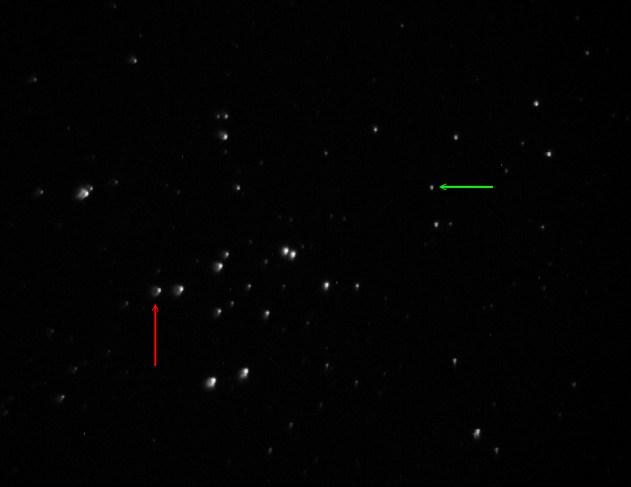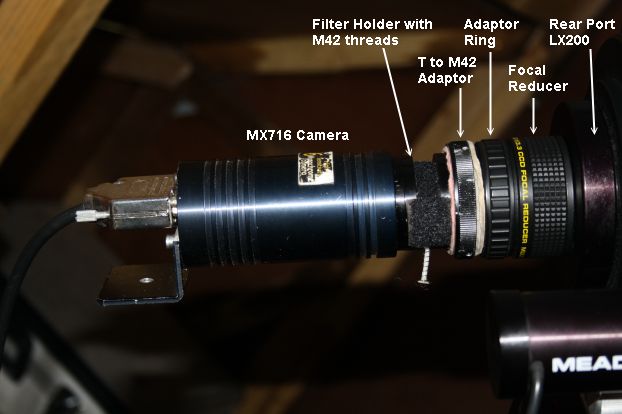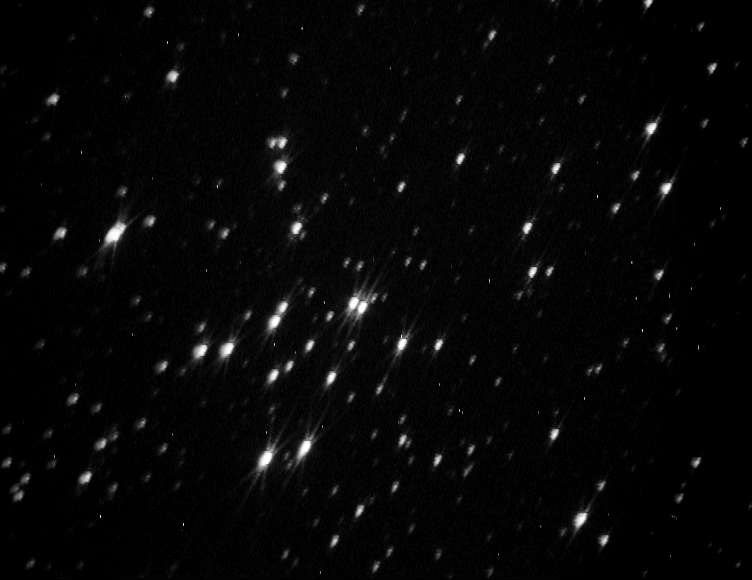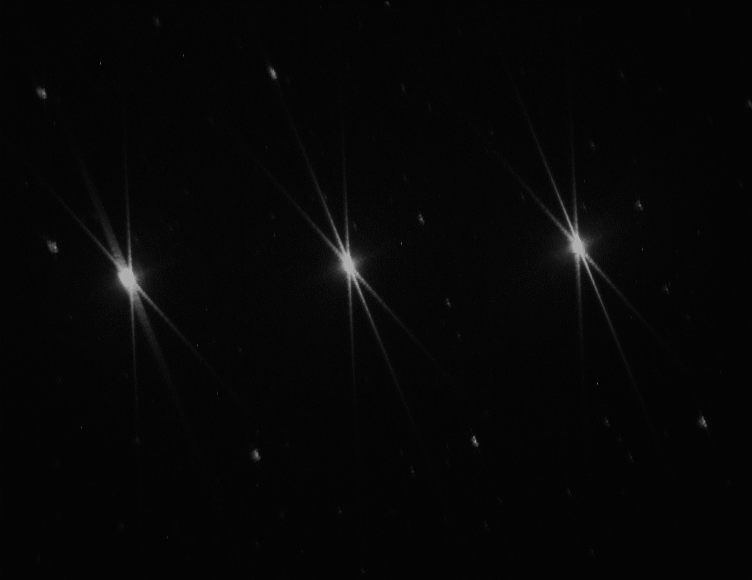

When I started using my Starlight Xpress MX716 camera, I found a problem when I used it with my 10-inch LX200 and Meade 0.33 focal reducer. The purpose of this page is to show the problem and some experiments I did to try to resolve it. I am hoping for help from the LX200 Yahoo Group who will make suggestions for further experiments if they don't have an immediate answer.
My test subject is M34 as the problem manifests itself on such open clusters. The first picture illustrates the problem. All the pictures here are single exposures and enhanced with star-mx software's non-linear stretch which acts like a positive gamma curve and increases contrast in the dark regions. In the first two images, you can see the unenhanced picture by moving your mouse cursor over the image.
This is the basic picture illustrating the problem.

|
Notice that the stars just right of centre appear as nice small dots (e.g. green arrow), but to the left have a circular shadow to their left (e.g. red arrow). This is the problem. Click here to see the same scene imaged with the same optics attached to my ETX 125. I've made the scales about the same but the orientation is a little different. However it shows that the camera-lens combination can work. (Use Back on your browser to get back here.) |
First of all here is a picture of the camera attached to the back of the telescope. Everything is screwed together firmly. I have thin home-made washers in some of the joints as I have had too much experience of being unable to unscrew them.
 This picture has confused some people, so some more explanation seems in order. On the right of the M42 adaptor is a cardboard washer which is much thinner than it looks. I have had it in use for a long time and the part that is not squashed between the rings has become frayed. On the left of the same ring is another washer made from thin pink card. The slot in the filter holder is covered by a piece of Velcro (this has been described as looking like a piece of foam) and the pin sticking out of the bottom is a plastic pin that pushes the filter out of the holder.
This picture has confused some people, so some more explanation seems in order. On the right of the M42 adaptor is a cardboard washer which is much thinner than it looks. I have had it in use for a long time and the part that is not squashed between the rings has become frayed. On the left of the same ring is another washer made from thin pink card. The slot in the filter holder is covered by a piece of Velcro (this has been described as looking like a piece of foam) and the pin sticking out of the bottom is a plastic pin that pushes the filter out of the holder.
My first thought was to check focus using my Bahtinov Mask.
Here is the picture of M34 taken through the Bahtinov mask.

|
If you look carefully at the diffraction spikes, you will see that on the central stars (look at those in the middle of the picture) the spikes are central indicating correct focus. Now look at the stars near the right-hand edge of the picture. The central spike is distinctly to the right of the outer pair. Now look at the bright star on the left-hand side. The central spike is distinctly to the left of the outer pair. |
I felt that this picture was cluttered and did not show the effect clearly so I took three pictures of a single star with it positioned left, central, and right. I then superimposed the three pictures and increased the contrast and brightness to bring the images back to about the same as the original pictures to produce the picture below.

|
I emphasise that the three pictures combined here were all taken within one minute without any change to the optics apart from a tiny change in the pointing of the telescope. This indicates that the focus is out one way on the right and the other way on the left. A sloping focal plane! The central spike of the left image is distinctly broadened in a way that the outer spikes are not. What does this mean? |
Bahtinov masks have an axis of symmetry, which means they have a direction, and I also wondered how my focus varied vertically in my pictures. So I repeated this experiment with 9 images of a single star placed in three rows across the picture. When I combined them, I got the picture below. Then I repeated the experiment with the mask rotated 90°, and got the picture shown in the mouseover

|
This picture shows the images when the mask had its axis of symmetry aligned north-south. In the mouseover you see the same thing with the mask rotated 90° clockwise (as seen from the camera). This seems to be telling me something rather disturbing. What do you think? (Return to Page 2.) |
Do I have astigmatism? This can be caused, I believe, by over-tightening the adjustment screws on the secondary mirror. If this is the case, it has been like that for several years. I hope the distortion is not permanent.... But would it cause the problem I started with?
Any better ideas would be very welcome.
Home Equipment Part 2 Part 3 Part 4 Part 5
Part 6 Part 7 Part 8 Part 9